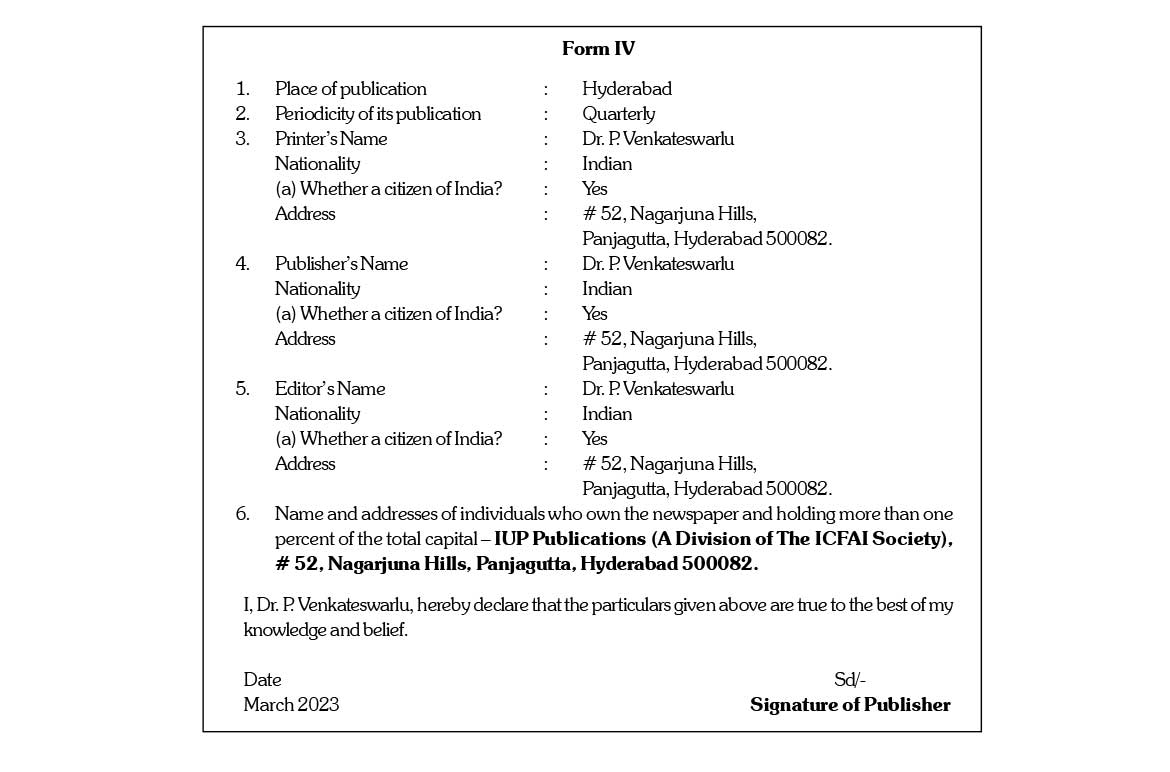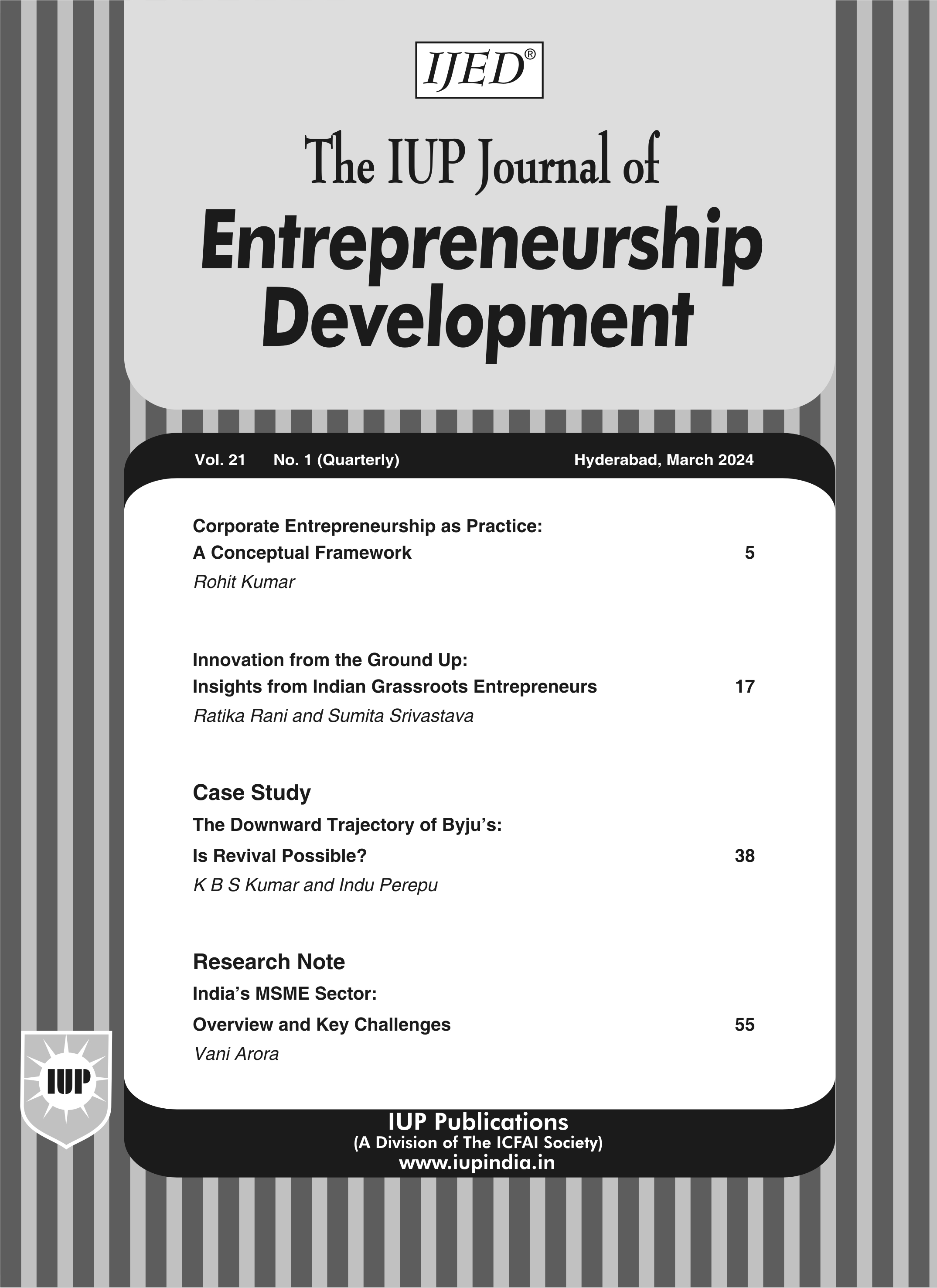
Mar'23
The IUP Journal of Entrepreneurship Development
Archives
Dynamics of Leadership Roles and Practices in Global Entrepreneurship Sustainability
John NkeobunaNnahUgoani
Professional Manager and Professor of Management, Department of Management Sciences, College of Management and Social Sciences, Rhema University, Nigeria. E-mail: John_ugoani@rhemauniversity.edu.ng; drjohnugoani@yahoo.com
Excellent management is often methodical and conservative. Therefore, effective leadership is always required to drive entrepreneurship sustainability. Leaders play primary and accessory roles. The primary roles include the leader's role as a visionary and planner, while the accessory roles include that of being a role model because of his position in the organization. A leader needs to guide the corporation on strategic goals and targets and be involved in short and long-term planning in the organization. There will always be the need to delegate duties where possible, and as far down the organizational hierarchy as practicable, consistent with ability and competence. Sustainability can thrive more through effective management education, training and development so as to create knowledge-based entrepreneurship culture as a foundation for a learning organization. Creating a learning organization is a global imperative because, ultimately, the leaders of the future require four important traits. They need to master internal markets and have a keen sense of external markets; they need to have a great relationship with people, a sound idea of ICTs, and a good understanding of how to perform exceptionally everywhere in the world. The study recommends that management succession planning driven by leadership must become a strategic game changer for global entrepreneurship sustainability.
Introduction
Leadership involves inspiring and guiding individuals and groups, a role that aims at getting others to do their jobs more effectively. At the apex of any human organization is the leader who is responsible for planning for the growth, performance and survival of the organization. As entrepreneur, the organizational leader plays the decisional role of committing organizational resources to develop and innovate goods and services. Leadership in organizations provides the important interpersonal role of setting good examples and providing direction concerning the use of financial, material and other resources to achieve goals.
The leadership roles and practices in global organizations encompass the evaluation of the performance of management teams in different functional areas and regions and taking necessary corrective measures to improve performance. Through the establishment of strategies and goals, leadership lays the foundation for generational growth and sustainability. Entrepreneurship sustainability, as used in this context, is explained by continuity and sustainable growth and used interchangeably with organizational sustainability to mean the same thing.
Entrepreneurship sustainability is related to organizational growth or culture that develops a pattern of sustainability by providing the values and beliefs that underpin organizational objectives (Ecceles et al., 2011). The CIPD (2012) also emphasizes the importance of organizational culture in seeking to explain entrepreneurship sustainability by referring to the creation of meaningful values that shape strategic decision-making and building a culture that reinforces desirable behavior to enhance sustainability (Ugoani, 2019). Current academic research in leadership describes a series of fascinating types of leadership, including two distinct types of leaders as transactional and transformational who can also be democratic, autocratic or otherwise. In organizational change, learning and transformation analysis, there is increasingly a loud chorus of agreement that successful leadership is often defined by performance, profitability or entrepreneurship growth. However, it is almost generally accepted that exceptional organizational leaders are imbibed with such qualities as passion, integrity, courage, discipline, knowledge, among others attributes.
The central dynamics of sound leadership also involve idealized influence, inspirational motivation, intellectual stimulation as well as individual consideration. On the basis of these attributes, roles, and practices, leadership is able to better influence management for performance and sustainability. Today, the story of many sustainable organizations around the world is the story of exceptional leadership. For example, the success story of Guinness worldwide is the success story of the leadership qualities of late Arthur Guinness. This became possible largely due to the ingenuity, creativity, sagacity and leadership capacity of the late Arthur Guinness (September 24, 1725 - January 23, 1803). The late entrepreneur established his brewery as a family business, on December 31, 1759, in Dublin. Through good leadership and management as well as an early management succession arrangement, the enterprise metamorphosed into a global brewery giant, spanning over 260 years or over two-and-a-half centuries (Guinness, 1999 and 2008; and Joyce, 2009).
The success story of Ford Motors is also the success story of the exceptional leadership qualities of late Henry Ford; the same for Microsoft and Bill Gates, Johnson & Johnson, among others. Ford Motors is now among the first global organizations to appoint a sustainability director to drive the sustainability policies of the corporation. According to Abolo (1999), leadership is required because someone has to point the way and that same person has to ensure that everyone concerned follows. He posits that organizational effectiveness depends on the quality of leadership. For example, Steve Jobs was a great organizational leader. He was distinct from other strong business leaders because of his extraordinary vision and evangelical zeal to direct people toward the future and dedication to the success and survival of the enterprise as a way of transforming the world by making Information and Communication Technologies (ICTs) available to everyone. Jobs, who gained a reputation for being ambitious to the point of megalomania, is now credited for his vision of a new world based on the Internet (Hill and Jones, 1995). Kotter (1990) believes that without leadership, firms cannot adapt to a fast-moving world. He posits that if organizations are going to live up to their potential, the need to find, develop, and encourage more people to lead in the service of others cannot be overemphasized. This is imperative because the goal of any human organization is not only to grow and survive, but also to sustain its existence by improving performance in the ever challenging global market (Schein, 1985; and European Commission, 2013). Management and leadership are related, but they are not actually the same. Sometimes, leadership refers to a process which helps to direct and mobilize people and their ideas, and at other times, it refers to a group of people in formal organizational positions where leadership is expected. While managers work by procedures, leaders work by people. Leadership involves influencing people by providing purpose, direction and motivation while aiming to accomplish goals and enhancing entrepreneurship interests.
Leadership assists in management development and training and also provides the building blocks for organizational performance, which is absolutely essential for the growth and survival of any enterprise. Leadership has one head but wears many hats. Therefore, leadership plays multiple roles in organizations and adopts multiple practices to suit multiple organizational situations to address any lacuna to ensure organizational performance and sustainability. For example, the management and leadership ability of late Sheik Mohammed El- Khalil (1890-1992) laid the foundation for the huge success of Seven-Up Bottling Company Plc. The company, which sprang up as a family business and incorporated as M. Khalil Transport Company in 1926, has passed through over five generations and remains among the most profitable, productive and sustainable entrepreneurships in Nigeria. According to Brinkmann (2019), measuring sustainability in a business context focuses on the triple bottomline of people, planet, and profit (Whipp, 1984; Nwuneli 2006; Nidumolu et al., 2009; Scott and Peter, 2009; Vissanu and Sarinthree, 2014; and Ugoani, 2018).
Conceptual Framework
A conceptual framework is the structure of the study that expresses the relationship among the major variables of the study. It is frequently stated in a schematic model. The conceptual framework of this study is shown in Figure 1. Cleary (1992) describes a model as a simplified representation of the real world.
The chairman of any organization is the chief driver of activities to ensure the survival of the enterprise, and he or she is often supported by a competent Chief Executive Officer (CEO). A major attribute of both the chairman and the CEO required for organizational leadership, success and sustainability is personal integrity. Leadership determines competitive advantage and how effectively an organization meets the needs of customers relative to others
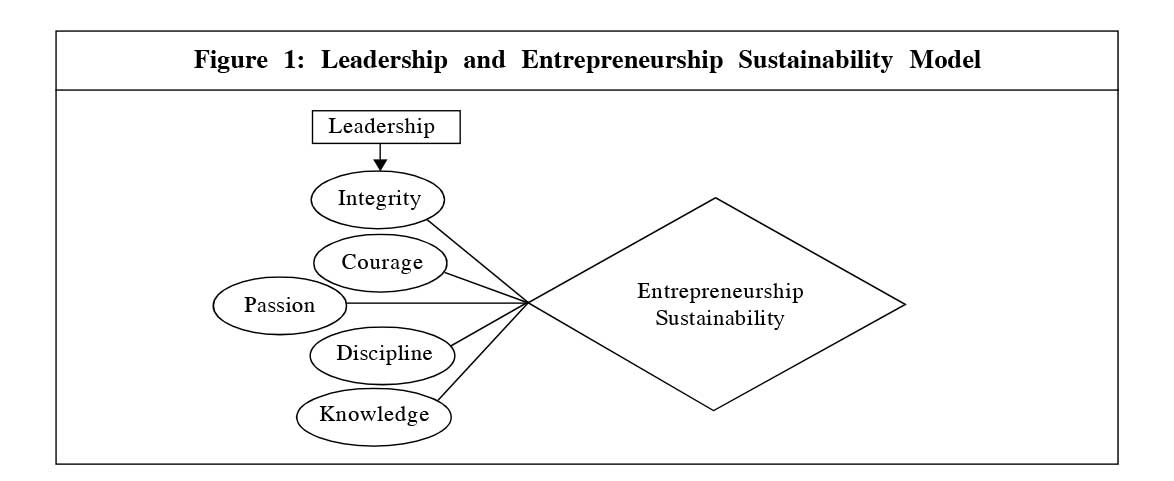
that offer similar goods or services. As in this conceptual framework, a model is an abstraction of reality.
Organizations use models to gauge the competencies that determine performance. The motivational factors to consider in leadership are the individual, his education, knowledge, experience, training and intelligence. If the person is physically and emotionally sound, he would take on more leadership tasks and grow psychologically. This motivational philosophy often applied by management is essential for superior organizational performance and survival (Ugoani, 2015). Nobody can strongly challenge the fact that the personal integrity of great leaders is not responsible for the generational sustainability of their corporations. Integrity is the quality of being honest and possessing strong moral principles and values. This condition provides the courage and passion for discipline, built on knowledge to lead the organization in the paths of performance and sustainability. Integrity in leadership includes transparency and accountability in dealing with the organization's financial, material and human resources, the strength of character in upholding the whole truth, and nothing less, but the whole truth, as well as behaviors according to prevailing business ethical standards. These attributes provide the leader with the power to make good business management decisions, which invariably provide for entrepreneurship sustainability. Growing entrepreneurships effectively requires longer planning horizons and confidence about the future stability and sustainability of the entrepreneurships. Leadership in this context, therefore, is not only about people but also the establishment of processes and proper decision making (Betts, 2004).
Literature Review
Leadership involves establishing direction, aligning people, and motivating them to achieve the long-term goals of the organization. Managers and leaders employ a mixture of leadership and management behaviors as applicable and closer to reality so that they can effectively play their roles for the survival of the organization. It is believed that a mixture of leadership styles like autocratic, persuasive, laissez fair, democratic, and others are necessary for entrepreneurship sustainability. Leadership roles and practices can no longer be at the mercy of any traditional leadership style that would not ensure sustainability. The Chairman or CEO should be an exceptional person who is aware of past corporate failures and then has a focus on today's success and tomorrow's failure. The leader should be an individual hero, a strong-willed and charismatic CEO who is committed to the success of the business. Because of globalization, improvements in ICTs, dynamic and changing workforce, changing expectations and values, there is now more than ever before the need for exceptional people to lead global entrepreneurships through the paths of sustainability.
Developing exceptional leadership skills is critical for success, and effective leaders are good at observing 'how to do it' and 'how not to do it'. They learn from their experiences and they keep on learning. Exceptional leaders take pains to analyze their successes and failures and learn from them. They promote the learning organization culture as the place where people stay to create the future they desire for themselves and for the sustainability of the organization (Senge, 1990; Marguardt and Reynolds, 1994; and Kirk and Kirk, 1997).
Objective
The study seeks to explore the relationship between leadership and entrepreneurship sustainability.
Research Significance
The result of the study will help students and researchers to refocus attention on the integrity of leaders for the sustainability of the enterprise.
Research Problem
Organizational leaders, instead of being role models, often disappoint themselves and their organizations due to lack of integrity and passion to lead their organizations to sustainability. For example, the failure of Etisalat, Enron, Worldcom and the challenges of many other organizations relate to the failure of leadership. This rise in reported cases of enterprise failures since the Global Financial Crisis makes a study of this nature imperative as a contribution to charting a way forward in the present competitive global market environment. A recent corporate leadership challenge would relate to Diamond Bank Plc in Nigeria, whose huge fortune dwindled due to leadership problems and its identity was squashed for a meager N72.5 bn by Central Bank of Nigeria in favor of Access Bank Plc. Diamond Bank Plc was on its way to becoming a great bank with all strategic intents and purposes but could not fly due to weak leadership and poor management succession planning in terms of chairman, CEO and executive directors (EDs) arrangements (Alagbe, 2018).
Research Questions
- Why do leaders fail in their positions?
- What are the effects of poor leadership in organizations?
- How can global entrepreneurships become more sustainable?
- Is good leadership needed for excellent organizational performance?
- What is the role of management skill in good organizational leadership?
Hypotheses Formulation
To achieve the objective of the study, the following hypotheses were formulated and tested at 0.05 level of significance:
H0: There is no relationship between leadership roles and practices and entrepreneurship sustainability.
H1: There is a relationship between leadership roles and practices and entrepreneurship sustainability.
Management Skills and Leadership
There are many reasons why people low in Management Skills (MS) can still be successful or good leaders, as illustrated in Table 1.
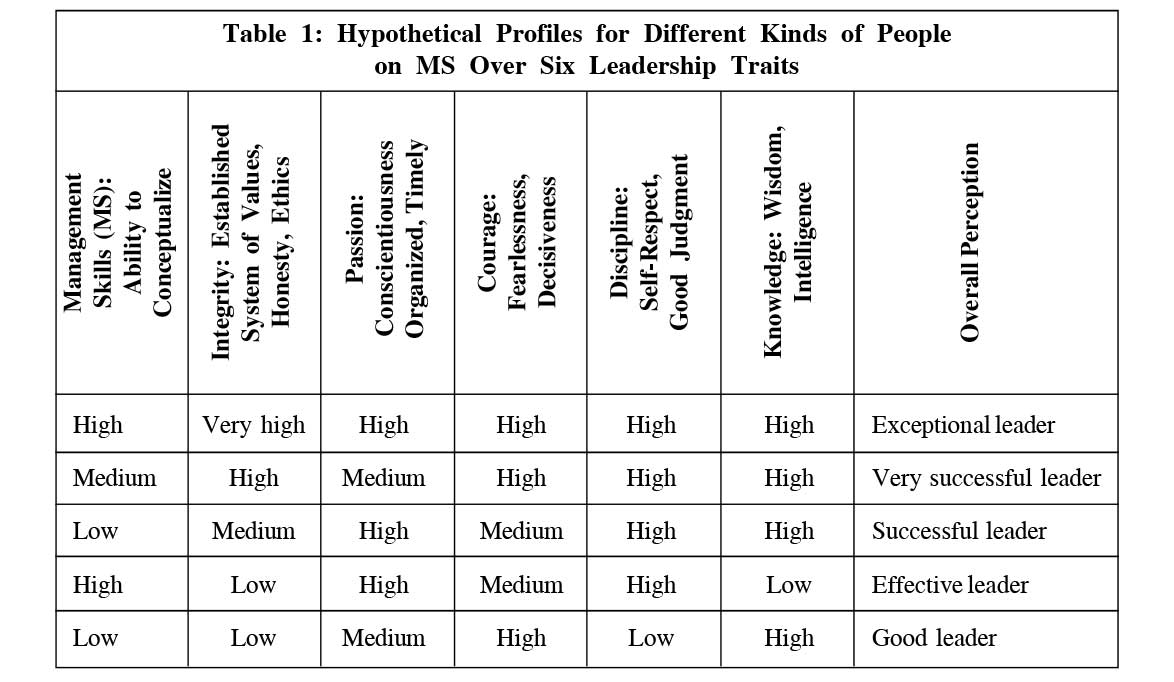
It is observed from Table 1 that a leader can employ other abilities aside from MS to succeed. Human beings exhibit a tremendous capacity to adapt to their own skills and choices in specific situations and environments to succeed despite any limitations. This also makes a case that other less effective people may score high on the leadership text. This text supports the notion in leadership and management literature that while management is mainly concerned with establishing detailed steps and timetables for achieving desirable performance, and then allocating the resources, leadership on the other hand is mostly involved with developing a vision for the future, often the distant future, and strategies for producing the changes required to achieve that vision, therefore, paving the way for entrepreneurship sustainability.
Excellent management by its nature is conservative, methodical, incremental, and short-term oriented. As a result, the best management may not produce major entrepreneurship change. An organization is like an organism and requires change for its growth, success and sustainability. In support of this, management requires the extra ingredient of exceptional leadership, and this postulation permits leadership to be singled out for study without the encumbrances of qualifications relating to the more general issues of management. It is clearer that a major qualification for leadership is integrity, which provides for equity, rights and obligations, responsibility, respect, fairness, ethical behavior, probity, transparency and accountability. This supports the idea of Maxwell (2005) that among the essential ingredients of leadership are hard work, friendliness, knowledge, respect, ethics and responsibility. He explains that leaders play multiple roles. As they move up in the organizational hierarchy, their rights decrease, while their responsibilities increase and their decision weighs more heavily on the organization. His idea is presented in Figure 2. The CEO has limited rights and freedom, less than the customer who has widest freedom to do whatever he or she wants. On the other hand, the responsibilities of the CEO increases, while those of the worker or customer decreases (Cicmil, 1997).
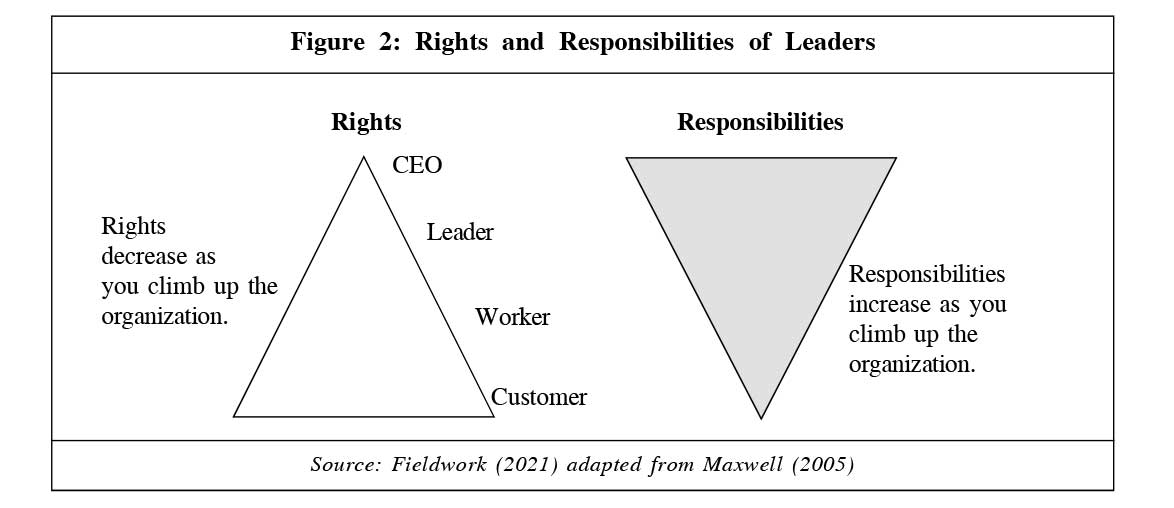
In any organization, the upper level is top management. The main job of top management is to plan how to solve any problems faced by the organization, make decisions, and formulate strategies to move the organization to the next level. However, top management must always exercise responsible leadership. Exceptional leadership is a vital tool of management which forms the framework for entrepreneurship sustainability (Zhu et al., 2005; Mujtaba and Cavico, 2013; and Mujtaba, 2014).
Leadership Process
Leadership is a complex process because it deals with complex situations and complex human beings. The leader has multiple roles to play, and the success or failure of the organization rests on the shoulders of the chairman or CEO who is the key actor in any organization. Ngwube (2010) stated that integrity is incredibly important, and it should be understood by any leader. He emphasized that leaders with integrity inspire confidence in others because they can be trusted to do what they say they will do. Leaders play primary and accessory roles. The primary roles include the leader's role as a visionary and planner, while the accessory roles include the leader's role as a role model, because of his position in the organization. The leader as a role model or as symbol of the group provides a focus for group unity. The leader must keep the momentum, despite the aggressions of any frustrated, disappointed and disillusioned people or groups, to enhance entrepreneurship sustainability through the leadership process.
A leader needs to guide the corporation on strategic goals and targets and be involved in short and long-term planning in the organization. There will always be the need to delegate duties where possible, and as far down the organizational hierarchy as practicable, consistent with ability and competence. Sustainability can thrive more through effective management education, training and development so as to create knowledge-based entrepreneurship culture as a foundation for a learning organization. Creating a learning organization is a global imperative because, ultimately, the leaders of the future require four important traits. They need to master internal markets and have a keen sense of external markets; they need to have a great relationship with people, a sound idea of ICTs, and a good understanding of how to perform exceptionally everywhere in the world (Adukwu-Bolojoko, 2010).
Leadership Dynamism
Leaders are needed at every level of the organization, and everything rises and falls on leadership. This presupposes that there is a strong relationship between leadership and sustainability of any organization. Leadership brings changes or innovations for organizational sustainability. According to Dixit (2016), organizational innovation and renewal are behind the success and sustainability of global automobile makers like Honda, Toyota and Ford, among others. She posits that the automobile industry is going to change more in the next 10 or 20 years, than in the previous 50 or 100 years, due to factors such as external competition and changing customer needs. Because of such changes and transformations, innovations will remain drivers of industrial change and renewal. She explains further that almost all features of a car are dependent on innovation: fuel efficiency, emissions, safety, driving dynamics and performance, among other features. Therefore, innovations aim at both product innovation and process innovation for cost efficiency and productivity that also aim at organizational growth and survival.
Leadership is a game changer. For example, Infosys of India became popular as a global IT provider under the leadership of Narayana Murthy until his retirement in 2011. As soon as he stepped aside, the company's huge fortunes began to dwindle, and this unfortunate situation led to his recall from retirement to lead the company once more, in 2013. According to Srivastava and Singh (2016), on Murthy's return to Infosys as the executive chairman in 2013, he joined the legacy of Michael Dell, Steve Jobs and Howard Schulz in the entrepreneurial hall of fame. His leadership was required to bring the corporation out of troubled times. As he accepted the comeback call, he brought back exceptional leadership to rebuild a desired Infosys within 36 months with the help of high quality team and the full dedication of every Infoscian. The Board of Directors (BODs) of the company then agreed that Murthy's entrepreneurial and leadership record and the long experience he had as a technology pioneer made him eminently qualified to lead the company out of its bad times, and to provide strategic direction for a desired future. Murthy's return supports the assertion that leaders become more limited in terms of their freedom than customers who have great freedom and can do almost anything they want (Colbert and Kurucz, 2007).
Data and Methodology
Exploratory research design was used for the study. The method is historical in nature and does not often require a huge sample. Both qualitative and quantitative techniques can be used in exploratory study to achieve the desired objectives. This method does not often involve a structured questionnaire (Cohen et al., 2000; and Flick, 2009).
Data was collected through secondary and primary sources. Secondary data are information that had been previously collected for some other purposes other than the research work at hand, while primary data is the information gathered, especially for the research objectives at hand. In management research, the best approach is to use multiple methods of collecting data, since they offer the researcher a chance to cross-check the information obtained through the various methods (Yin, 2014). The sources included journal articles, books, surveys, interviews, and observations.
The population of the study comprised all the public enterprises quoted on the Nigerian Stock Exchange (NSE). Purposive sampling method was used in the study, while sample ratio concept was used to determine the size (Teddlie and Yu, 2007).
The study was conducted in Southeast Nigeria comprising five states out of the 36 states in Nigeria. It is assumed that the opinion of the people (sample size 150) in the Southeast is adequate enough to represent the opinion of the entire population of Nigeria. The demographic profile of respondents is given in Table 2. The study was conducted in 2022.
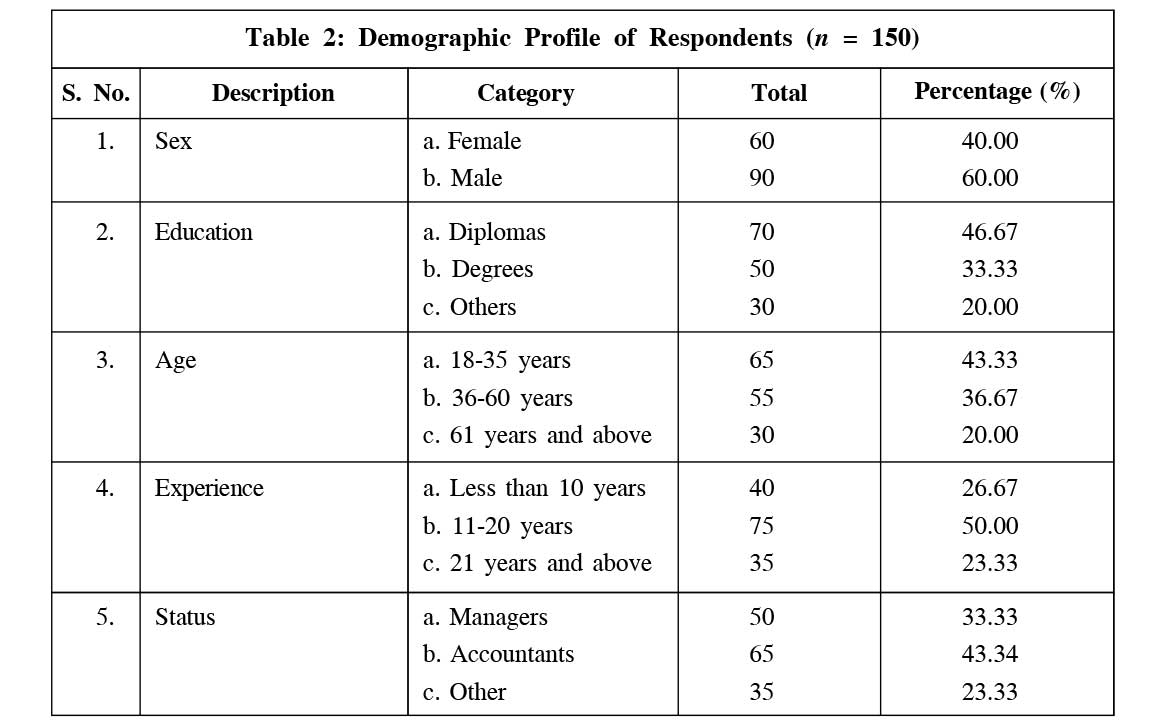
The decision rule for the mean cut-off for the analysis of responses to the research statements was set at 3 points. According to Nwankwo (2011), this method is appropriate for accepting or rejecting responses to research statements.
Data Analysis
Data was analyzed through descriptive and regression statistical methods and the results presented in tables.
Model Specification
Model specification is the expression of a relationship into precise mathematical form. According to Koutsoyainnis (1977), economic theory does not indicate the functional form of any relationship. This means that economic theory does not state whether a relationship will be expressed in linear form, quadratic form or in cubic form. On the strength of the above, it was decided to specify the relationship between Leadership (LP) and Entrepreneurship Sustainability (ES) as below:
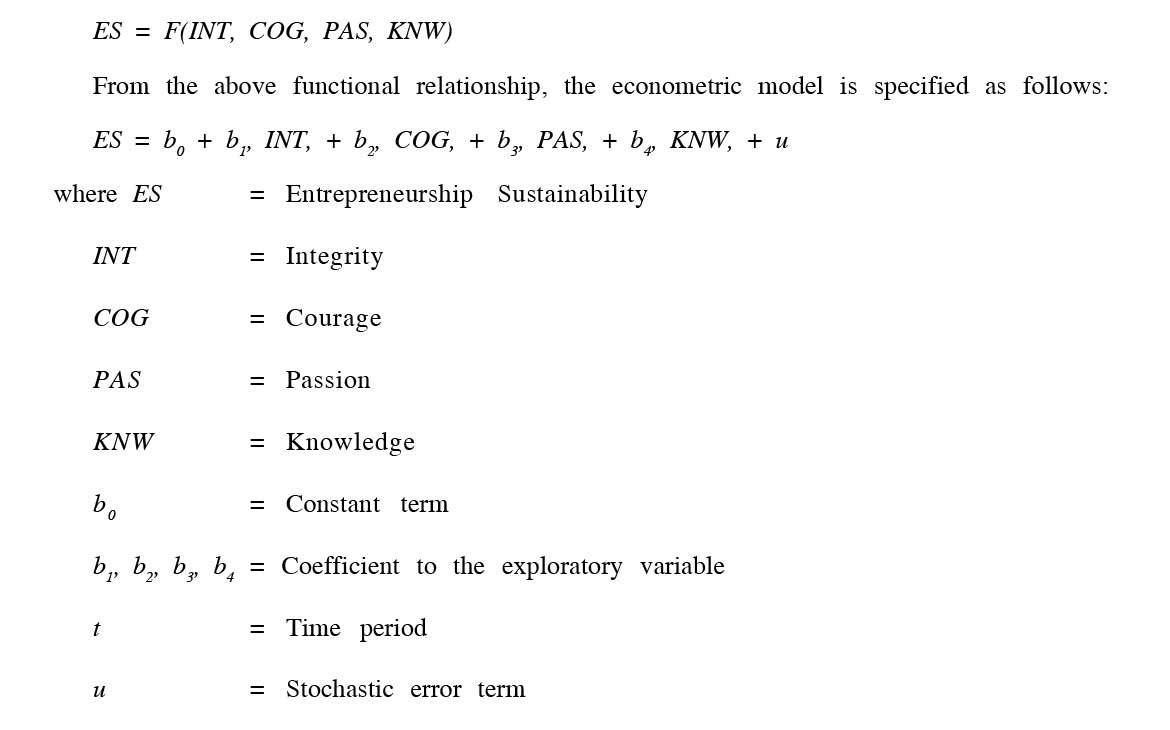
Results and Discussion
The model in Figure 1 provides the psychometric relationship between the independent and dependent variables of the study. This also provided the basis to argue strongly that leadership has a relationship with entrepreneurship sustainability as hypothesized (H1). Exceptional leadership makes for a professional, well-managed enterprise with strong management continuity, and entrepreneurship growth, profitability and sustainability. Table 1 was used to express the belief that exceptional leaders possess multiple high management and leadership skills and traits. As shown in Figure 2, leadership entails both self-denial and high responsibility. People who want to lead others must be prepared to be their servants. It is often the good servant-leader that promotes entrepreneurship sustainability. The consensus opinion of respondents, as shown in Table 3 with a grand mean of 3.17 over the cut-off mean
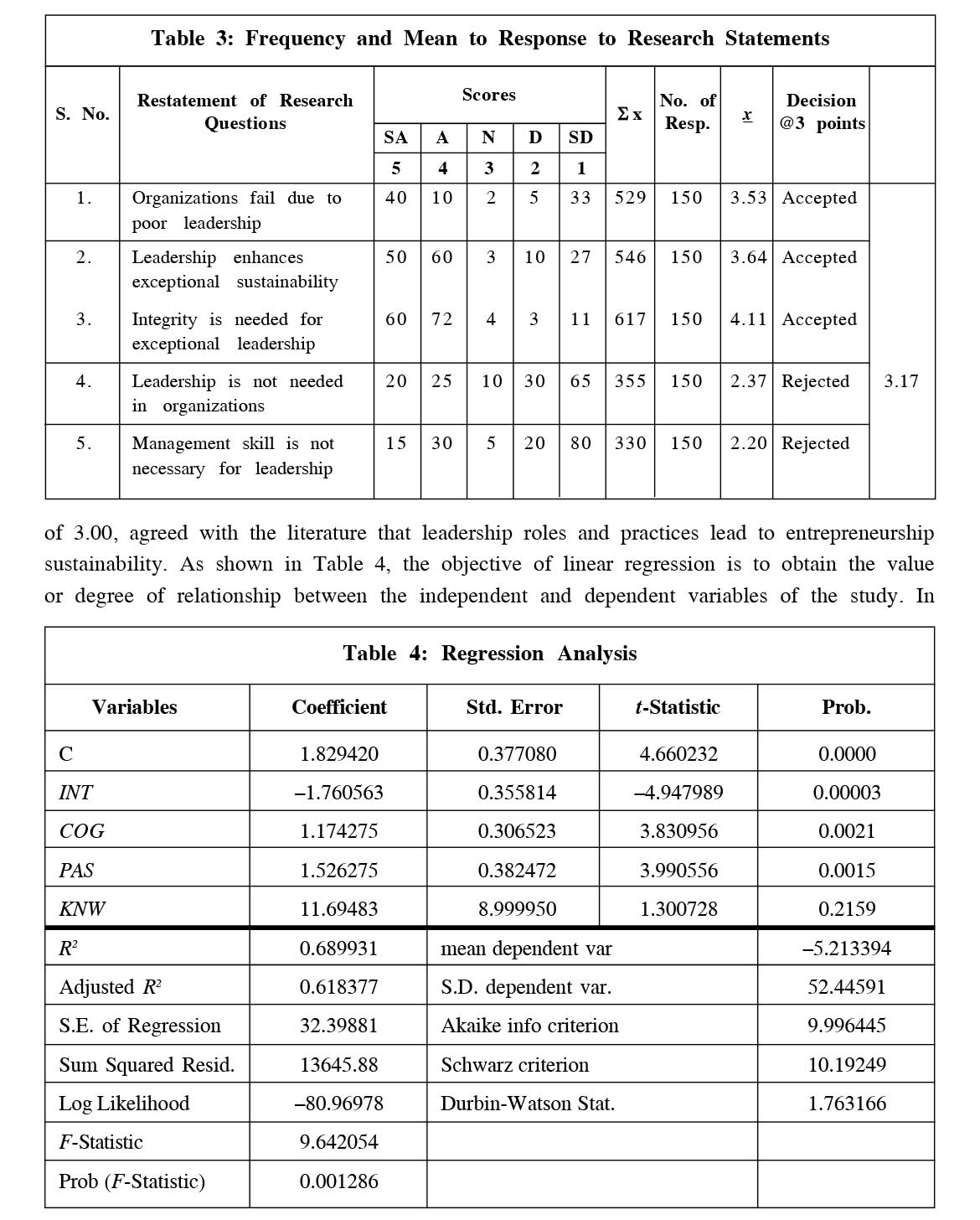
regression analysis, the possible value of R2 ranges from 0 - 1.00. The closer R2 is to 1.00, the greater the percentage of the explained variation. A high value of R2 of about 0.80 or more would indicate that the independent variable is a good predictor of the values of the dependent variables of interest. A low value of about 0.25 or less would indicate a poor predictor, and a value between 0.25 and 0.80 would indicate a moderate predictor. Therefore, the R2 value of 0.69 in this study suggests that leadership adequately explains entrepreneurship sustainability and H1 is accepted.
Leadership is fundamentally sensitive to context, and its outcomes are often influenced by those who make the choice. However, leadership must be concerned with linking action with people at all levels of the enterprise. In leading for change and entrepreneurship sustainability therefore, the critical leadership tasks will then involve harnessing the total set of knowledge, skills, attitudes and opportunities that the enterprise requires to compete effectively in the global marketplace. Exceptional leaders are learning enthusiasts, and among the 10 greatest social entrepreneurs of all time, including Muhammad Yunus, Bill Drayton, Willie Smits, Ibrahim Abouleish, and Bunker Roy among others. Roy founded the Barefoot College which specializes in teaching illiterate women from poor villages how to become medical doctors, engineers, and architects. His leadership and entrepreneurship initiative is helping in improving the quality of production and life of people in Asia and Africa. Before, and in this 21st Century, leadership and entrepreneurship sustainability cannot be over-orchestrated.
Leaders in economic growth now regularly gather in different parts of the world to discuss Global Entrepreneurship Paradigms (GEPs). Such discussions almost always aim at bringing out the brightest information as a key driver in empowering and stimulating the global private sector and world business as a whole. These business leaders encourage thousands of entrepreneurs around the world to pursue their expansion programs as global economic drivers for fostering international investments that will offer diversified solutions and opportunities that will remain relevant for future global entrepreneurship sustainability. Top entrepreneurs in the world like Bill Gates and others have strong influence on leadership patterns and economic sustainability in the world. Also, in Africa and Nigeria, for example, top entrepreneurs like Aliko Dangote, Femi Ofedola, Abdulbamad Rabiu, among others, leverage their massive economic power in making positive contributions to the leadership and economic sustainability of the continent as a whole, and Nigeria in particular (Otedola, 2021). This is the objective of the study. The results support the view of Rowe (2001) that strategic leadership role is critical for creating organizational wealth and sustainability.
Recommendations
- Organizations need to hire exceptional CEOs with a focus on long-term goals to ensure the success, growth and sustainability of their enterprises.
- Management succession planning must mean a strategic game plan for any organization to enhance performance and drive entrepreneurship sustainability.
- Global entrepreneurship should, without exception, metamorphose into learning organizations to provide the necessary environment for competent people to create the future for themselves and for their organizations.
- A strategic entrepreneurship approach towards entrepreneurship sustainability would mean for organizations to retain credible leaders with the capacity for global networking to give them the capacity to collaborate in the face of global competition to survive.
- Organizations should embrace robust Corporate Social Responsibility (CSR) and Environmental Social Responsibility (ESR) programs as necessary commitments to enhance their reputation and sustainability.
Conclusion
Integrity, passion and courage are among the critical ingredients of exceptional leadership that can promote entrepreneurship sustainability. Integrity enhances the culture of ethics, discipline as well as CSR that contribute positively to organizational performance and sustainability. Exceptional leadership demands sacrifice and responsibility for the achievement of strategic entrepreneurship goals. Exploratory research design was used for the study, and the result showed positive relationship between leadership roles and practices and entrepreneurship sustainability.
Future Scope: Entrepreneurship sustainability is important for economic growth, therefore, further study should examine the influence of capital formation on economic sustainability.
Acknowledgment: The author thanks Professor Bob Brinkmann whose work on Environmental Sustainability in a time of change inspired the crafting of this academic paper.
References
- Abolo E M (1999), "Developing Exceptional Leadership in Organizations: First Bank of Nigeria Plc", Monthly Business and Economic Report, pp. 1-14.
- Adukwu-Bolojoko S N (2010), "Inspired Leadership", Management in Nigeria, Vol. 46, No. 3, pp. 4-5.
- Alagbe J (2018), "Merger: How Diamond Bank Lost its Sparkle", Westafrica Business News, Vol. 5, No. 270, pp. 1, 4 & 5.
- Betts S C (2004), "Resolving a Paradox Between Mentoring, LMX and Charisma: A Process Approach to Leadership Development", Journal of Organizational Culture Communications and Conflict, Vol. 8, No. 1, pp. 111-125
- Brinkmann R (2019), Environmental Sustainability in a Time of Change, Palgrave, New York.
- Cicmil S (1997), "Achieving Completeness Through TQ Principles and Organizational Learning", The Learning Organization, Vol. 4, No. 1, pp. 30-34.
- CIPD (2012), "Responsible and Sustainable Business: HR Leading The Way a Collection of Thought Pieces", CIPD, London.
- Cleary R (1992), "Models as Effective Research Tools", in D M Cavanash and G M Rodwell (Eds.), Dialogues in Educational Research, William Michael Press, Darwin NT, Australia.
- Cohen L, Manion L and Morrison K (2000), Research Methods in Education, Routledge Falmer, London.
- Colbert B and Kurucz E (2007), "Three Conceptions of Triple Bottomline Business Sustainability and Role for HRM", Human Resource Planning, Vol. 30, December, pp. 21-29.
- Dixit S (2016), "Survival to Innovation: A Case of Honda Cars India", Amity Business Journal, Vol. 5, No. 2, pp. 38-52.
- Ecceles R, Ioannou I and Serafein G (2011), "The Impact of a Corporate Culture of Sustainability on Corporate Behaviour and Performance", National Bureau of Economic Research, No. W17950, Cambridge.
- European Commission (2013), "Entrepreneurship as a Main Driver for Economic Growth. Brussels", European Commission, Memo/13/5 09/10/2013
- Flick U (2009), An Introduction to Qualitative Research, 4th edition, Sage Publications, London.
- Guinness M (1999), The Guinness Spirit, Hodder & Stoughton, London.
- Guinness P (2008), Arthur's Round, Peter Owen Publishers, London.
- Hill C W L and Jones G R (1995), "Steve Jobs as a Visionary Leader" in C W L Hill and G R Jones (Eds.), Strategic Management: An Integrated Approach, 3rd Edition, Houghton Mifflin Company, pp. 27-29, Boston. ISBN: 0-395-70943-1
- Joyce J (2009), The Guinnesses: The Untold Story of Ireland's Most Successful Family, Poolbeg Press, Dublin.
- Kirk J J and Kirk L D (1997), Training Games for the Learning Organizations, McGraw-Hill, New York.
- Kotter J P (1990), "What Leaders Really Do", Harvard Business Review, Vol. 68, pp. 103-111.
- Koutsoyainnis A (1977), Theory of Econometric, Macmillan Education Ltd., London.
- Marguardt M and Reynolds A (1994), Global Learning Organizations, Irwin, New York.
- Maxwell J C (2005), The 3600 Leader: Developing Your Influence from Anywhere in the Organization, Tennessee, Thomas Nelson, Inc., p. 16, ISBN: 0-7852-6072-7
- Mujtaba B G (2014), Managerial Skills and Practices for Global Leadership, ILEAD Academy, Davie, Florida.
- Mujtaba B G and Cavico F J (2013), "Corporate Social Responsibility and Sustainability Model for Global Firms", Journal of Leadership, Accountability and Ethics, Vol. 10, No. 1, pp. 1-11.
- Ngwube I I (2010), "Leadership For Change", Management in Nigeria, Vol. 46, No. 3, pp. 7-14.
- Nidumolu R, Prahalad C K and Rangaswami M R (2009), "Why Sustainability is Now the Key Driver of Innovation", Harvard Business Review, Vol. 87, No. 9, pp. 56-64.
- Nwankwo O C (2011), A Practical Guide to Research Writing for Students of Research Enterprise, (Revised Edition) Port Harcourt, Pam Unique Publishers Co. Ltd. ISBN: 978-978-49599-4-0
- Nwuneli N O (2006), Defying the Odds: Case Study of Nigerian Organizations That Have Survived Generations, Lagos, LEAP Africa. ISBN: 978-068-345-3
- Otedola F (2021), "My Role in Resolution of Political Logjam During Yar'Adua's Illness by Otedola: Entrepreneurs Must Engage with Political Leaders", The Nation, Vol. 13, No. 5495, p. 7.
- Rowe W G (2001), "Creating Wealth in Organizations: The Role of Strategic Leadership", The Academy of Management Executive, Vol. 15, No. 1, pp. 81-94.
- Schein E H (1985), Organizational Culture and Leadership. Jossey-Bass, San Francisco.
- Scott M H and Peter W (2009), "Empirical Investigation of the Effects of Transformational and Transactional Leadership on Organizational Climate", Journal of Applied Psychology, Vol. 4, No. 16, p. 18.
- Senge P (1990) The Fifth Discipline: The Art and Practice of Learning Organizations, Doubleday/Currency, New York.
- Srivastava P and Singh S (2016), "Narayana Murthy: The Table Turner in Troubled Times?", Amity Business Journal, Vol. 5, No. 2, pp. 31-37.
- Teddlie C and Yu F (2007), "Mixed Methods Sampling: A Typology with Examples", Journal of Mixed Methods Research, Vol. 1, No. 1, pp. 77-100.
- Ugoani J N N (2015), "KICS: A Model of Motivational Leadership in Organizations", Independent Journal of Management and Production, Vol. 6, No. 3, pp. 585-602.
- Ugoani J N N (2018), "Effective Management Decision Making and Operational Effectiveness in Nigeria", Amity Business Journal, Vol. 7, No. 2, pp. 1-8.
- Ugoani J N N (2019), "Sustainable Management of Enterprise Resource Wealth and Business Sustainability", International Journal of Economics and Business Administration, Vol. 5, No. 1, pp. 34-43.
- Vissanu Z and Sarinthree U (2014), "The Influence of Leadership Styles in Organizational Performance Mediated by Organizational Innovation: A Case Study of the Hospitality Industry in Thailand", 2014 International Conference on Economics, Management and Development.
- Whipp R (1984), "The Art of Good Management: Managerial Control of Work in the British Pottery Industry 1900-1925", International Review of Social History, Vol. 29, No. 3, pp. 359-385.
- Yin R K (2014), Case Study Research Design: Design and Methods, 5th Edition, Sage Publishers, Thousand Oaks.
- Zhu W, Chew I K and Spangler W D (2005), "CEO Transformational Leadership and Organizational Outcomes: The Mediating Role of Human Capital-Enhancing Human Resource Management", The Leadership Quarterly, Vol. 16, No. 1, pp. 39-52.
